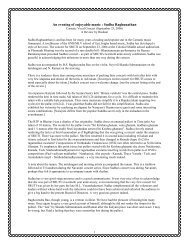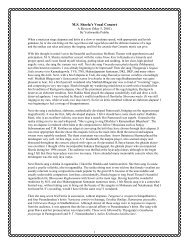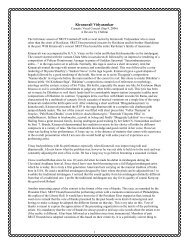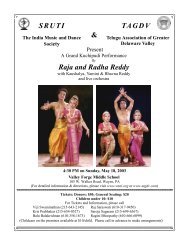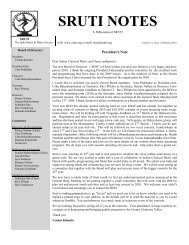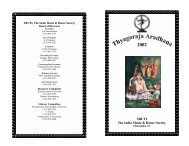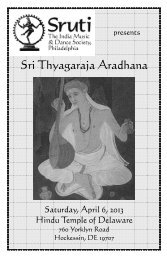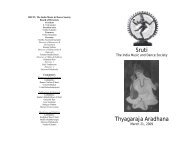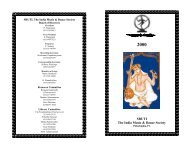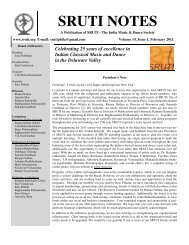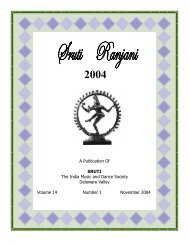Addtnl. Program Notes - Sruti
Addtnl. Program Notes - Sruti
Addtnl. Program Notes - Sruti
- No tags were found...
You also want an ePaper? Increase the reach of your titles
YUMPU automatically turns print PDFs into web optimized ePapers that Google loves.
ODISSIThe temple looks out at a turbulent sea. For centuries, its walls have danced a prayer tothe rising sun. In magnificent ruins like these, there is evidence that the ancient danceform known as Odissi was performed in Orissa as far back as the 2 nd century BC - asacred ritual dedicated to the gods. This makes it one of the oldest dance traditions in theworld. Sinuous forms, languorous limbs and rapt expressions frozen in stone tell tales ofa past filled with dance, music, myth and legend.Odissi is characterized by sensuousness and lyricism. With movements that reflect themotifs of Orissa temple sculpture, it captures drum rhythms, melodies, as well as thepoetic meaning of songs taken from the vast canon of Oriya music. It speaks of love andunion, between human and divine, transporting viewers to enchanted worlds.NRITYAGRAMAt Nrityagram dance village, dance is a way of life. The founder, Protima Gauri - anexquisite Odissi dancer herself - converted ten acres of farmland into an ideal setting forthe study, practice and teaching of classical dance. Reminiscent of ancient ashramswhere gurus imparted not only technique but also a philosophy of being, it is a creativespace where dancers, musicians and choreographers live together, sharing their skillsand developing their art. The dancers study yoga, meditation, martial arts as well asSanskrit, mythology and literature. As knowledge passes from guru to disciple, thecontinuity of the classical arts is ensured.The outside world, too, is an integral part of Nrityagram. Choreographers, movementspecialists, sculptors, painters, writers, musicians and theatre people from all over theworld, frequently visit the village to perform and give workshops and seminars on theirart. Nrityagram’s proudest achievement is its annual spring festival, Vasantahabba, an allnight performance of music and dance, the roster of which includes some of the greatestnames in India, attended by over forty thousand enthusiastic spectators streaming infrom surrounding villages - and beyond.The Nrityagram Dance Ensemble is regarded as one of the foremost dance companiesof India. Since 1996, the year of their life-changing New York debut, they have toured theUS annually. They have performed at sold-out shows from New York to Hawaii andBozeman, MT to Key West, FL.In ’03 and ’04, their soloists were invited to perform at the Edinburgh Fringe Festival (atDance Base - National Center for Dance). In addition, the Ensemble has performed inDenmark, Holland, Portugal, the Middle-east, Singapore, Japan, etc.Although steeped in and dedicated to ancient practice, Nrityagram dancers are alsoinvolved in carrying Indian dance into the twenty-first century. Thanks to grants from theNational Dance Project of the New England Foundation for the Arts and most recently,the Joyce Theater, they not only develop new work, which explores creative ways toexpand on tradition, but also are able to commission music from leading composers ofIndian classical music, like Pandit Raghunath Panigrahi of Orissa, and the brothersGanesh Kumaresh from south India.
Their first full-length production, Sri - In Search of the Goddess, premiered in New Delhiin 2001and in the US in 2002. It was made possible by the Doris Duke Fund for Dance ofthe National Dance Project. Sri - In Search of the Goddess toured the United Statesextensively in 2002 – 2003 to great critical acclaim.The next production, Ansh, which premiered in Denver in 2005, consisted of a reconceptionof a typical Odissi recital, which normally progresses from mangalacharan (aninvocation), through pallavi (pure dance) and traditional abhinaya (narrative dance), tomoksh (‘dance of liberation’). Included in the US Tour 2005 was a week long run at theJoyce Theater, New York.Sacred Space, which was made possible by the Doris Duke Fund for Dance of theNational Dance Project, premiered in Chennai in December 2005. Sacred Space wasawarded the best production of the season by the prestigious Music Academy, Chennaiand toured the United States for six months in 2006, including stops at Spoleto festival,Jacobs Pillow Dance Festival, etc.The newest production, Pratima: Reflection has been commissioned by the JoyceTheater’s Stephen and Cathy Weinroth Fund for New Work. The world premiere ofPratima: Reflection was in February 2008 at the Joyce Theater, New York. Vibhakta fromPratima: Reflection, was listed in “The 10 best dance performances of 2008” by JoanAcocella, The New Yorker (12/9/2008)CREDITSThe Nrityagram DanceEnsembleManasi TripathyRasmi RajPavithra ReddyBijayini SatpathySurupa SenMusic ComposerPandit Raghunath PanigrahiAssisted by Srinibas SatapathyRhythm ComposerDhaneswar SwainSurupa SenCostumesGhulam Rasool TailorLighting DirectorLynne FernandezArtistic Director/ChoreographerSurupa SenExecutive DirectorLynne FernandezUS RepresentativePentacle / DanceWorks Inc.Sophie Myrtil-McCourty212-278-8111 extn 313sophiem@pentacle.orgNrityagram – The Dance Villagewww.nrityagram.orgnrityagram@gmail.com<strong>Sruti</strong> gratefully acknowledges the support rendered by Helen Haynes, Brent Woodsand their team at Montgomery County Community College through the planning andexecution stages of this presentation.Thanks are due to Sophie Myrtil-McCourty, David Claps and the team at Pentacle for theprofessional interaction during the contract process and for working out of the logistics.
PROGRAM NOTES- PRATIMA: REFLECTIONPRAARAMBHA (hymn of creation)At first, there was but ONE.That ONE thing, breathless, breathed by its own nature,beyond that, there was nothingness.From within the depths of darkness engulfing darkness,emerged the first seed of desire to become.It grew out of its own warmth and transversely spread its cosmic rays.The great sages saw this in their mind’s eye.Who knew the way? Who then declared from whence it came?(Even the Gods came after.)The ONE, from whom creation unfoldedknowsor perhaps, knows not.(Translation of Naasadiya Sukta; Rig - Veda X. 129)Dancers: Manasi Tripathy, Pavithra Reddy, Rasmi Raj, Bijayini Satpathy, Surupa SenCHHAYA (image)A submission to the inherently lyrical form of Odissi, this dance explores the variousdimensions of its abstract vocabulary.Imagesof the dance and the dancer.Never separate, one enhancing the other.The reflections unite, multiply, gently embellish themselves.And grow languidly in the sensuous realms of Odissi.Dancers: Bijayini Satpathy, Surupa Sen, Manasi Tripathy, Rasmi Raj, Pavithra Reddy.MUGDHA (lost in love)An excerpt from ‘Sacred Space’A poem from the Geet Govind is interpreted through facial expressions (bhava) andgestures (mudra). Written in Sanskrit in the twelfth century by the saint poet Jayadeva,the Geet Govind is a romantic ballad about the immortal love of Radha and Krishna. It isa song of love and longing that reflects the Vaishnava belief, that all of humankind is afeminine energy (Radha) constantly seeking union with the one male godhead (Krishna).Annoyed with Krishna, who flirts with other women, Radha is in a state of jealousy andyearning.The Sakhi (friend) brings a message to Radha, that Krishna awaits her. She says:In the dark of the nighton the banks of the Yamuna river…adorned with wildflowers and jewels,Krishna waits.His flute calls out your name,as he wanders through the forest caressing the breezefor your touch.He prepares a bed of love.and his eyes search anxiouslyat every stir of a leaf.
Do not linger any further, oh sensuous-hipped onecast away the traitorous bells from your anklesand drape yourself with the night.Hasten to your beloved,he awaits you.Dancers: Pavithra Reddy, Manasi Tripathy, Rasmi RajINTERMISSIONVIBHAKTA (the division) **In the union and the separation of the male and female principle lies the secret of allcreation. It is believed that creation begins when, with the power of yoga, the ONE splitsinto two and becomes Ardhanareshwara (half-man half-woman). In this form both halveslive in perfect symphony - at once distinct and separate as well as harmonious andblended. Each acknowledges and celebrates the existence of the other.“Her body is the colour of a champa blossom,his is like camphor;her body is sprinkled with musk-vermillion powder,his is smeared with the ash of funeral-pyres;she is adorned with anklets and bracelets of gold,he wears a multitude of glistening snakes;she wears a garland of mandaar flowers,he wears a garland of skulls;she is draped in silks,he is clad by the sky;her hair is dark like the monsoon clouds,his matted locks flash with lightening.Her dance creates the universe.His Tandava dissolves everything.I bow to the mother of the universe.I bow to the father of the universe.Om namah Shivaa.Om namah Shivah.”(Ardhanareshwara Stotra attributed to Shri Adi Shankara)Ardhanareshwara Stotra is a hymn sung by a devotee. We interpret it as a poem, whereShivah, the male principle, sings his adoration to his beloved other half. And Shivaa, thefemale aspect, describes the glory of her magnificent counterpart.It becomes at once, a love song and a celebration of the ‘duality’ of the human spirit.Dancers: Surupa Sen, Bijayini Satpathy** Listed in “The 10 best dance performances of 2008” - Joan Acocella, The New Yorker(12/9/2008)AARATI (offering of light)A salutation to the presiding deities of Odissi dance - the goddess Vimala and LordJagannath.“From you comes all life; and into you we must all return”.Dancers: Bijayini Satpathy, Pavithra Reddy, Rasmi Raj, Manasi Tripathy
Artist BiographySURUPA SEN (Artistic Director, choreographer, soloist)was the first student at Nrityagram, where she began her Odissi training with the latebody language genius and architect of Odissi, Guru Kelucharan Mahapatra. She alsostudied with Protima Gauri, founder of Nrityagram, and Abhinaya with Smt. KalanidhiNarayanan.As a child she studied Bharatanatyam, to which she attributes her pre-occupation withform and line. Attracted to choreography from her first exposure to western makers ofdance, she participated in the International Choreographer’s Residency at the AmericanDance Festival in 2000, thanks to a grant from the Asian Cultural Council.Surupa has performed in solo recital and ensemble all over India, North America,Europe, the Middle East and the Far-East.Her first evening length work Sri: In Search ofthe Goddess (2000), consisted of both a nontraditionalsuite (Night, Fire, & Dialogue withDeath) & a re-working of traditional dance(Srimati, Srimayi, & Sridevi).Her next production Ansh (2004) was a reworkingof a typical Odissi recital, which touredextensively including a run at the JoyceTheater, New York in 2005.Sacred Space (2006), a show based onTemple Architecture and its relationship todance, used an expanded traditional Odissivocabulary. For Sacred Space, Surupareceived the award for best choreography fromthe Music Academy, Chennai.Pratima: Reflection is an evening-length workthat explores the relationship between thedancer and her dance as she seeks to find animage of herself through the essential truths –of Creation, Contemplation, Separation andthe Duality of the human spirit.She received the Raza Foundation Award forExcellence in Dance in 2007. And the Yagnaraman Award for Excellence in Dance, fromSri Krishna Gana Sabha, Chennai in 2008.Surupa is Artistic Director and choreographer at Nrityagram.BIJAYINI SATPATHY (Director of Odissi gurukul, soloist)joined the Orissa Dance Academy in Bhubaneshwar at the age of 7, where she trainedfor 13 years under the tutelage of Guru Kanduri Charan Behera, Guru Pagal Swain,Bichitrananda Swain & Aruna Mohanty.An insatiable thirst for knowledge led her to Nrityagram in 1993 where she flourishedunder the guidance of Protima Gauri, and through her collaboration with Surupa Sen.
At Nrityagram she gained from the intense concentrationon dance that it promotes, as well as from interactionwith other practitioners of performing arts, to which sheattributes her own artistic growth.Bijayini has performed alone, and with the ensemble, allover the world and has received national andinternational recognition including the 2003 MahariAward given to the best Odissi dancer of the year andthe Bismillah Khan Yuva Puraskar 2007 given by theSangeet Natak Akademi to the best in performing arts inIndia.As Director of the Odissi Gurukul, Bijayini works oncreating new techniques for Odissi dance training, andextending the vocabulary of the traditional form.PAVITHRA REDDY (dancer) came as part of the outreach programme in 1990, from avillage near Nrityagram. She has learned Odissi under the tutelage of Surupa Sen andBijayini Satpathy and been a part of the ensemble since 1993. She had her solo debut in2003 & now teaches dance in our village and city outreach programme.RASMI RAJ (dancer) studied at Orissa Dance Academy in Bhubaneshwar for 5 yearsbefore she came to Nrityagram for advanced training. Here, she has learned with SurupaSen and Bijayini Satpathy. Rasmi has been with Nrityagram for six years and is theyoungest dancer in the ensemble.MANASI TRIPATHY (dancer) is from Srujan dance academy in Bhubaneshwar, whereshe trained for 11 years before coming to Nrityagram. Now she trains under Surupa Senand Bijayini Satpathy. She is the newest dancer in the ensemble.LYNNE FERNANDEZ (lighting director, Executive Director Nrityagram)has been with Nrityagram since 1993. Among the first practicing light professionals inIndia, she has worked as actress and light designer with leading directors like BarryJohn, Joy Michael, Ranjit Kapoor, and Lillete Dubey. Her work in theatre has also beenfeatured internationally – at the Edinburgh Fringe festival, the Westend (London) and off-Broadway, New York.Of her work with the ensemble, Surupa Sen says “she understands dance intuitively andis able to create the visual space that enhances our work. Her contribution is theluminosity, the look that has become characteristic of the ensemble”.As Executive Director of Nrityagram, Lynne is responsible for administration, fund raising,project development, amongst other things. Her recent projects include building a dancefacility with a studio, auditorium, exhibition space and physiotherapy unit. She has alsooverseen the emergence of the ensemble onto the international arena.



